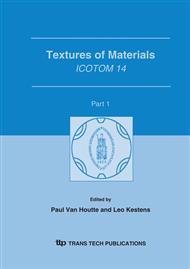p.381
p.387
p.393
p.399
p.405
p.411
p.417
p.423
p.429
Microstructure and Texture Evolution of Cold Worked 304 Stainless Steel Experimental and Modelling
Abstract:
A micromechanical model was used to simulate the mechanical behaviour, the transformation kinetic and the texture evolutions of a 304 stainless steel, deformed by tensile tests at T=–60°C. When the transformation strain is calculated with the phenomenological theory, the model does not very well predict the observed transformation rate and the texture evolution of the main γ grain orientations. XRD and EBSD analyses show that the martensitic transformation of γ phase into α’ martensite involves the intermediate ε phase. From these observations, new simulations were performed in which only the γ→ε transformation strain is considered in competition with classical plasticity of austenite. The α’ variants were calculated in a second step, from the ε variants selected in the micromechanical model. Among the 6 potential α’ variants able to nucleate from the same ε variant, the best oriented ones, with respect to the applied stress were selected. Under these conditions, the numerical simulations reproduce the experimental results in a more satisfying way.
Info:
Periodical:
Pages:
405-410
Citation:
Online since:
September 2005
Authors:
Price:
Сopyright:
© 2005 Trans Tech Publications Ltd. All Rights Reserved
Share:
Citation:


